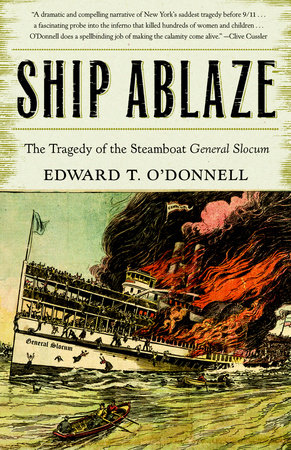 Certain disasters dwell in the public consciousness long after they take place. The sinking of the RMS Titanic on April 15, 1912 took the lives of 1,500 people. In the 110 years since the sinking, numerous books and films, along with a voluminous amount of scholarship have ensured that the memory of the event lives on. Not all tragedies receive such long-lasting commemoration, even if they had an enormous impact in their time and place. The sinking of the PS (Paddle Steamer) General Slocum shocked New York City almost 120 years ago. It would remain the deadliest disaster in the city’s history until the terrorist attacks of September 11, 2001. However, today few people are familiar with it, especially in comparison to the lasting fame of the Titanic and Lusitania disasters. Historian Edward T. O’Donnell attempts to correct this imbalance in his 2004 book, Ship Ablaze: The Tragedy of the Steamboat General Slocum.
Certain disasters dwell in the public consciousness long after they take place. The sinking of the RMS Titanic on April 15, 1912 took the lives of 1,500 people. In the 110 years since the sinking, numerous books and films, along with a voluminous amount of scholarship have ensured that the memory of the event lives on. Not all tragedies receive such long-lasting commemoration, even if they had an enormous impact in their time and place. The sinking of the PS (Paddle Steamer) General Slocum shocked New York City almost 120 years ago. It would remain the deadliest disaster in the city’s history until the terrorist attacks of September 11, 2001. However, today few people are familiar with it, especially in comparison to the lasting fame of the Titanic and Lusitania disasters. Historian Edward T. O’Donnell attempts to correct this imbalance in his 2004 book, Ship Ablaze: The Tragedy of the Steamboat General Slocum.
On the morning of June 15, 1904, the Slocum departed Lower Manhattan, carrying 1,312 passengers and 30 crew members, bound for picnic grounds on Long Island. Saint Mark’s Evangelical Lutheran Church, of Manhattan’s Little Germany neighborhood, had chartered the steamboat for its annual summer outing. Most of the passengers were women and children, all looking forward to a fun-filled day. Sadly, they would never reach their destination. The first reports of fire aboard the wooden steamboat came around 10 a.m., half an hour after the vessel had left Manhattan. When Captain William Van Schaick was notified about ten minutes later, he gave the order–which would later prove controversial–to go full speed ahead and beach the ship on nearby North Brother Island. The fire consumed the beached Slocum, which burned near North Brother Island before breaking loose, floating away, and sinking off the coast of the Bronx.
1,021 people died in the disaster, either in the fire or by drowning. It was an unspeakable tragedy for all of New York City, but especially for the Little Germany neighborhood and the parish of St. Mark’s. The close-knit community was decimated by the enormous loss of life. Reactions and condemnations, were swift. What, or who, was to blame for this tragedy? Some thought Captain Van Schaick’s decision to head for North Brother Island, sailing into the wind, ultimately cost lives that could have been saved. Others pointed fingers at the Knickerbocker Steamboat Company, which operated the Slocum, and its president, Frank Barnaby. The company’s casual attitude towards safety, combined with lax and corrupt inspection standards, allowed the vessel to pass inspection despite having useless, decaying life preservers and faulty firefighting equipment.
O’Donnell’s book covers the story’s major players, from the residents of Little Germany to the Slocum’s crew to the first responders and investigators who helped the survivors during and after the disaster. The author also introduces other key players, including New York City mayor George B. McClellan, Jr. and journalist Martin Green. His overview of New York during the time period of the disaster includes notes on steamboat travel, popular entertainment (including a spectacle at Coney Island where the audience watched a staged fire), and city politics. O’Donnell succeeds in reviving the memory of a tragedy long since eclipsed in notoriety by more recent events. Pick up Ship Ablaze for a detailed, engaging look at a neglected historical event.